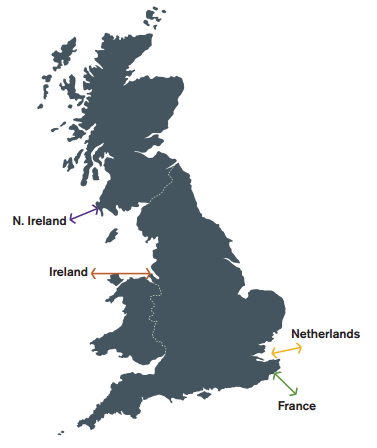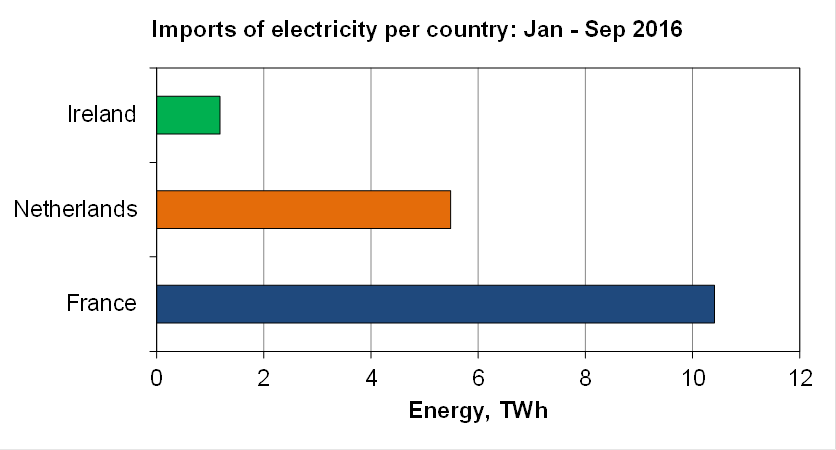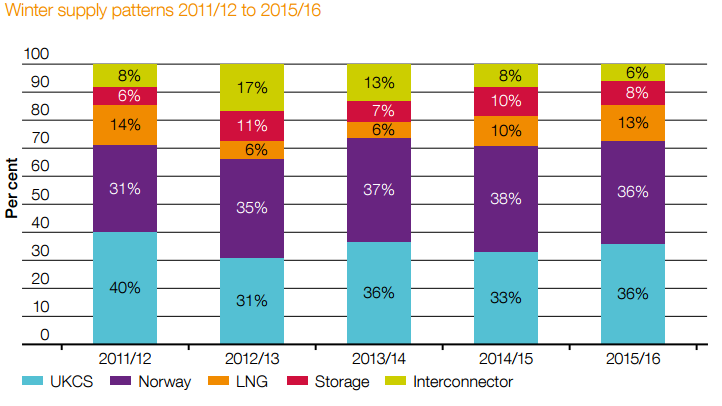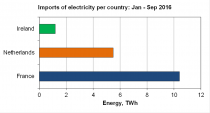In this blog, I assess how we import electricity to Great Britain and evaluate whether this is a low carbon thing to do. I conclude that to reduce carbon emissions from our electricity we should think carefully about where our imports come from and when we do so.
In this blog, I assess how we import electricity to Great Britain and evaluate whether this is a low carbon thing to do. I conclude that to reduce carbon emissions from our electricity we should think carefully about where our imports come from and when we do so.
What are interconnectors and what are they for?
Interconnectors are subsea electricity cables between the British National Grid and that of France, The Netherlands and Ireland. These interconnectors enable the trading of electricity across borders and so allow National Grid to purchase cheap electricity from abroad and also provide an option of backup in the event of a shortage of power in Britain.

Location of interconnectors to Great Britain. Source: Ofgem
Having a wide variety of available energy sources is important for having a reliable electricity supply on and interconnectors should be viewed alongside gas peaking plants, nuclear plants and pumped storage facilities as a mix of technologies which give us reliable electricity.
It is important to remember that, like everything in the electricity system (from Nuclear power stations to the drivetrains in wind turbines), interconnectors are not 100% reliable. Sometimes these cables fail, as happened this winter during a storm (read here) and during May at the same time as major fossil fuel plant failed (read here).
More interconnectors are planned to France, Belgium, Ireland, Norway, Denmark and Iceland. Having more interconnectors will improve the chances of us being able to import or export electricity as well as providing more options to trade electricity.
How much electricity do we import from abroad?
Overall in Britain imports around 6% of her electricity needs over a year through interconnectors to France, The Netherlands and Ireland.
In the chart below we see where our imported electricity came from between January and September 2016. Most of our import in 2016 was from France but some 39% of our imports were from Ireland and The Netherlands.

Energy imported to GB from different countries, Jan – Sep 2016. Source: www.mygridgb.co.uk
How do our neighbours generate their electricity?
In the table below, I have compiled how France, The Netherlands and Ireland generated electricity in 2014 using data from the IEA. France is heavily dependent on nuclear power whilst The Netherlands and Ireland use a higher proportion of coal, gas and renewables.
| Country | France | The Netherlands | Ireland |
| Coal | 2.1% | 31.3% | 24.6% |
| Gas | 2.3% | 49.8% | 49.1% |
| Nuclear | 77.6% | 4.0% | 0.0% |
| Hydro | 12.2% | 0.1% | 3.8% |
| Other renewables | 5.4% | 12.8% | 21.8% |
| Other | 0.4% | 2.0% | 0.7% |
Electricity mix of countries to where Britain has interconnectors, Source: IEA Statistics, http://www.iea.org/statistics/
How green is the electricity we are importing?
Let’s not forget that climate change is a global problem so if our electricity is generated abroad and emits loads of carbon, that has an impact on the UK through climate change. To help understand the greenhouse emissions from importing electricity, I have estimated the carbon intensity of their electricity (using the carbon intensity factors used in the rest of this website) and tabulated these in the table below.
We see how France is has a very low carbon intensity compared to Britain (just 46gCO2eq/kWh) because it has a high amount of nuclear and hydro power.
The Netherlands and Ireland however are heavily reliant on coal and gas and so have much higher carbon emissions than the GB average.
| Source of electricity |
Average carbon intensity of electricity gCO2eq./kWh |
| French Interconnector |
46 |
| Netherlands Interconnector |
521 |
| Irish Interconnectors |
454 |
| Great Britain, 2016 |
300 |
| Coal Power Station |
820 |
| Gas Power Station |
490 |
Should this affect when we import?
Because France has a much lower carbon intensity, we can quickly concluded that electricity from France displaces higher carbon electricity in Great Britain.
We might also conclude that importing power from Ireland or The Netherlands actually adds to our carbon emissions in Great Britain. When we really think about this, we find that that isn’t the case because it is important lastly to consider the alternative. If we did not import from The Netherlands or Ireland we would be required to switch on fossil fuel plant.
If that is coal generation at 820 gCO2/kWh then importing from The Netherlands or Ireland is the less polluting thing to do. If that is gas generation at 490 gCO2/kWh then we find that importing from Ireland will reduce our carbon footprint whilst Dutch electricity remains the worst option.
If our objective is to minimise carbon emissions, we should therefore only import from The Netherlands when it has a lower carbon footprint. This may happen if it is particularly windy or sunny in Holland but not in the UK or if The Netherlands has switched off all of it’s coal power stations and National Grid have restarted plants in Britain.
There is a great map of European carbon emissions at this link. When it works, you can see when we are importing and the relative carbon emissions of ourselves versus our neighbours. Alternatively, to view when Britain is importing you can use the dashboard on this page.
Interconnectors aren’t our only source of imported energy
Although interconnectors do add to the overall provision of reliable power, they can be controversial because the need to import of electricity from our neighbours goes against the thought that Britain is “energy independent”. It should be noted here that nearly every form of electricity generator in the UK relies on some form of import; the majority of our fossil fuels is imported; nuclear fuel is imported; much of our solar panels are manufactured abroad etc. The following chart from the National Grid Winter Outlook 20016/17 highlights this well. It shows that less than 50% of our gas is provided from the UK Continental Shelf (UKCS). That is gas used for generating electricity as well as heating and in industry.
As an aside, the National Grid Winter Outlook and Summer Outlook are good reads.

Winter supply of gas to Great Britain where UKCS is the UK Continental Shelf and LNG is imported Liquified Natural Gas. Source: National Grid Winter Outlook 2016/17, http://www2.nationalgrid.com/UK/Industry-information/Future-of-Energy/FES/Winter-Outlook/
Further Reading
Ofgem Interconnectors Factsheet: https://www.ofgem.gov.uk/sites/default/files/docs/2014/05/electricity_interconnectors_factsheet.pdf

